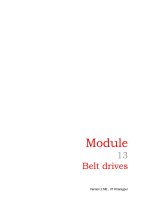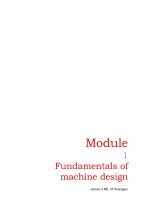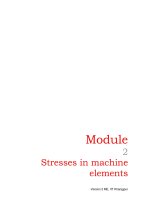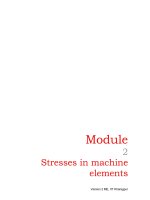Fundamentals of Machine Design P38
Bạn đang xem bản rút gọn của tài liệu. Xem và tải ngay bản đầy đủ của tài liệu tại đây (133.49 KB, 9 trang )
Module
13
Belt drives
Version 2 ME , IIT Kharagpur
Lesson
2
Design of Flat Belt
drives
Version 2 ME , IIT Kharagpur
Instructional Objectives:
At the end of this lesson, the students should be able to understand:
• Features of flat belt drives
• Flat belt materials
• Flat belt stresses and its specifications
• Types of design factors
• A sample design procedure.
13.2.1 Flat belt drives
Flat belts drives can be used for large amount of power transmission and there is
no upper limit of distance between the two pulleys. Belt conveyer system is one
such example. These drives are efficient at high speeds and they offer quite
running. A typical flat belt drive with idler pulley is shown in Fig. 13.2.1. Idler
pulleys are used to guide a flat belt in various manners, but do not contribute to
power transmission. A view of the flat belt cross section is also shown in the
figure.
C
Fig.13.2.1 Belt drive with idler
Idler pulley
t
b
Flat belt cross-section
The flat belts are marketed in the form of coils. Flat belts are available for a wide
range of width, thickness, weight and material. Depending upon the requirement
one has to cut the required belt length from the coil and join the ends together.
The fixing of the joint must be done properly because the belt normally gets
snapped from the improper joints. The best way is to use a cemented belt from
the factory itself or with care one can join these belts with various types of clips
that are available in the market.
Version 2 ME , IIT Kharagpur
13.2.2 Belt Material
Leather
Oak tanned or chrome tanned.
Rubber
Canvas or cotton duck impregnated with rubber. For greater tensile strength, the
rubber belts are reinforced with steel cords or nylon cords.
Plastics
Thin plastic sheets with rubber layers
Fabric
Canvas or woven cotton ducks
The belt thickness can be built up with a number of layers. The number of layers
is known as ply.
The belt material is chosen depending on the use and application. Leather oak
tanned belts and rubber belts are the most commonly used but the plastic belts
have a very good strength almost twice the strength of leather belt. Fabric belts
are used for temporary or short period operations.
13.2.3 Typical Belt drive specifications
Belts are specified on the following parameters
Material
The decision of the material to be used depends on the type of service.
No. of ply and Thickness
Ply is the number of layers as indicated earlier. Therefore, the number of ply is
decided depending upon the belt tensile strength required for a given power
transmission.
Maximum belt stress per unit width
The belts are subjected to tensile load only. Therefore, the allowable tensile load
depends on the allowable stress on the belt and its cross sectional area. It is
customary to provide the belt stress value for a given belt thickness and per unit
belt width. Hence, a designer has to select a belt thickness and then calculate
the required belt width. Otherwise, one can calculate the belt cross sectional area
and then adjust the belt thickness and the width from the standards.
Version 2 ME , IIT Kharagpur
The maximum belt stress is also dependent on the belt speed. Hence, the
maximum belt stress (for a given belt thickness and per unit belt width) is
provided either for different belt speeds or for a specified speed.
Density of Belt material
Density of Belt material is provided as, per unit length per unit cross section.
Density of Belt material is required to calculate the centrifugal force on the belt.
Coefficient of friction of the belt material
Coefficient of friction for a pair of belt material and pulley material is provided in
design data book.
13.2.4 Modification of Belt stress
When Maximum belt stress/ unit width is given for a specified speed, a speed
correction factor ( C
SPD
) is required
to modify the belt stress when the drive is
operating at a speed other than the specified one.
When angle of wrap is less than 180
0
:
The maximum stress values are given for an angle of wrap is 180
ο
for both the
pulleys, ie, pulleys are of same diameter. Reduction of belt stress is to be
considered for angle of wrap less than 180
ο.
. The belt stress is to be reduced by
3% for each ten degree lesser angle of wrap or as specified in a handbook. For
e.g., if the angle of wrap is 160
ο
, then the belt stress is to be reduced by 6%.
This factor is given as C
W.
13.2.5 Design considerations for flat belt drives
Transmission ratio of flat belt drives is normally limited to 1:5
Centre distance is dependent on the available space. In the case of flat belt
drives there is not much limitation of centre distance. Generally the centre
distance is taken as more than twice the sum of the pulley diameters. If the
centre distance is too small then rapid flexing of the belt takes place and some
amount of belt life will be lost.
Depending on the driving and driven shaft speeds, pulley diameters are to be
calculated and selected from available standard sizes.
Belt speed is recommended to be within 15-25 m/s.
A belt drive is designed based on the design power, which is the modified
required power. The modification factor is called the service factor. The service
Version 2 ME , IIT Kharagpur









